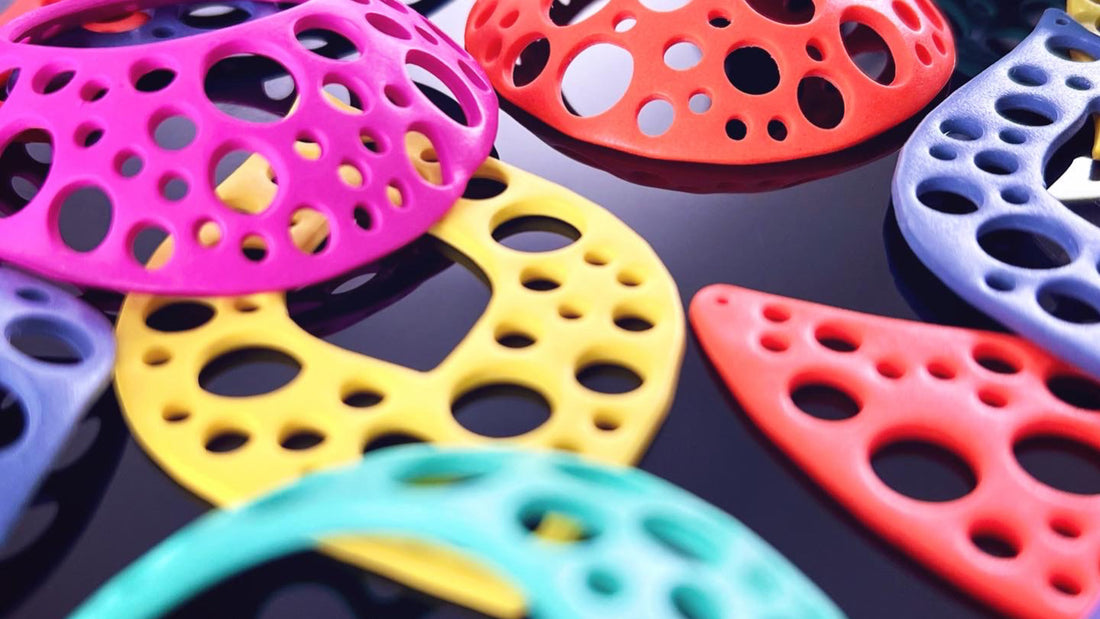What is the best polymer clay jewellery?

Share
With a seemingly endless choice of polymer clay jewellery for sale online, it can be difficult to make a choice with confidence. In this article I hope to help you discover more about polymer clay jewellery, what it is, the pros and cons, what to look for, and of course... where to get your hands on some of the most unique jewellery you'll find online!
What is polymer clay?
Polymer clay is a non-toxic, synthetic modelling medium based on PVC (polyvinyl chloride). It does not air dry, instead remaining soft and pliable, easy to

mould and cut into almost any shape desired, until cured by baking.
Once cured, polymer clay becomes slightly flexible and very durable, and is incredibly lightweight compared to metals such as gold and silver, making it a popular choice amongst jewellery designers and creators. With an ever-growing range of colours and effects to choose from, the possibilities for creativity are endless!
What should I look for before purchasing polymer clay jewellery online?
Because the popularity of polymer clay has exploded in recent years, so too has the number of small businesses selling their jewellery created with the versatile material. The skill levels of the individual makers can vary greatly, likewise the quality of the finished product.
To help you feel confident in making an online purchase, here are a few things to consider...
- Finishing: Zoom in on photos of jewellery pieces and check for any rough edges. Sanding of completed pieces is essential to remove jagged edges that will catch on clothing and feel rough against the skin, but is occasionally overlooked, particularly by beginner jewellery makers.
- Photo angles: What do the backs of the earrings look like? The insides of the bracelets? What type of clasp is used? Handcrafted items will often have tell-tale signs like fingerprints or air bubbles, but you want to at least see what you will be getting, so you can decide accordingly.
- Dimensions: Shown either in photographs or written dimensions in the description (or both). The size of jewellery pieces can often come as a surprise... One person's idea of big can be very different than another's!
- Description of materials: What materials have been used to make the item, besides the polymer clay? Stainless steel, gold or sterling silver for example? Is it coated with resin or varnish? Plastic beads or precious gems? A lack of this information can leave you, the potential customer, open to disappointment. In some cases, it has the potential to lead to unintentional allergic reactions.
What is so great about polymer clay jewellery?
Why all the hype? Is it really any good? Here's a little more insight for you...
Polymer clay jewellery pros:
- Excellent durability: When crafted by a skilled maker, polymer clay jewellery will easily withstand everyday wear and tear, allowing you to enjoy styling with your favourite pieces for many years!
- Workability: Because of its ability to be rolled, flattened, squashed and cut, polymer clay jewellery can be created in the most amazing shapes and styles.
- Amazing colours and effects: Not only is it available in a vast array of fashion colours, textures and effects (such as "glow-in-the-dark"), polymer clay can be painted, dusted with glitter and mica powders, mixed with alcohol inks, coated with the glossiest resins...the designs are limited only by the imagination of the maker.
- Lightweight: Polymer clay is very lightweight, especially when compared with the likes of traditional jewellery materials such as gold and silver, gemstones and even some woods. This makes it a particularly popular choice for the creation of large earrings, where too much weight would otherwise cause discomfort to the wearer.
- Water resistance: Being oil-based, polymer clay is waterproof when cured, however some care should be taken to avoid prolonged contact with water to protect any surface finishes such as varnishes etc, which are generally water resistant, but not waterproof. Please do not bathe while wearing polymer clay jewellery!
...And cons?
- Colour fading: The colour fastness of polymer clay is generally excellent, however the techniques used to add other colours to the clay may not be so resilient (alcohol inks and paints, for example). That being said, you can ensure the vibrancy of your jewellery for years to come by simply storing it in a cool, dry, dark place between uses.
- Durability: While very durable, polymer clay is not as strong as materials such as metals, resins and woods. It can be broken when placed under excessive stress. However, simply treating your pieces with due care should all but eliminate this risk.
Why else is polymer clay jewellery a great option?
Small business support! Purchasing polymer clay jewellery is an easy way to support a small business that has created your pieces by hand. And because they are handcrafted, they are extra special... often even one-of-a-kind!
Blazon Jewellery for example, is a small business in Tea Tree Gully, South
Sole owner and creator, Kathy Marano, is passionate about producing fun, stylish statement earrings and bracelets that you won't find elsewhere, while keeping them affordable for the average jewellery enthusiast. Her creations have been shipped from their origin in Australia, to as far away as the United States and Canada! Check out her story here: About Blazon Jewellery




 Australia, that has been creating and selling unique polymer clay jewellery since mid 2021.
Australia, that has been creating and selling unique polymer clay jewellery since mid 2021. 






